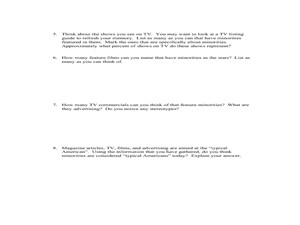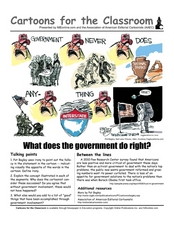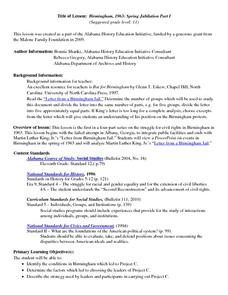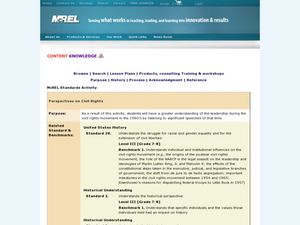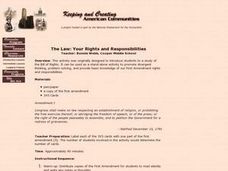Albert Shanker Institute
Who Was Bayard Rustin?
Who was Bayard Rustin? Pupils analyze a series of primary source documents to learn about this important figure in the civil rights movement. The lesson contains a short film to watch along with guiding questions and other resources...
Curated OER
Relationships, Day 4: Friendships & Dating
It is so important to help special needs individuals know the difference between dating and friendship. They define friendship, differentiate between friends and strangers, role-play, practice greetings, then talk about dating. This...
Center for Civic Education
In the Shadows, Agents of Change
Most of your learners have probably heard of Martin Luther King, Jr., or Cesar Chavez, but could they also recognize the names of Betty Friedan or Dolores Huerta? Give your learners the opportunity to discover the many accomplishments of...
Curated OER
Minorities in Mainstream American Society
So many people fought for Civil Rights in the United States. Read about the Civil Rights Act of 1964, and discuss what the act guarantees. Then pass out a slew of magazines and encourage them to observe how often minorities appear in...
Curated OER
Life as a Refugee
Lesson 1 from a Refugees and Human Rights unit is based on the UNHCR video “Working with Refugees.” Pupils gain an understanding of the role the United Nations plays in protecting and assisting refugees worldwide and have an opportunity...
Curated OER
Grapes of Wrath: Setting up Historical Context
Discuss life in the 1930s in relation to the Dust Bowl and Great Depression, then do a cross-media analysis. Here you'll find background information on film maker John Ford, writer John Steinbeck, and 1930s America. You can compare the...
Curated OER
Students Press Law and Ethics
Learners research the rights and the responsibilities of journalists in dealing with First Amendment issues. In this First Amendment lesson plan, students research the Alien and Sedition Acts and study the five elements of...
Odell Education
Making Evidence-Based Claims: Grade 8
American women have been working toward equal rights since the ink dried on the Declaration of Independence. Focused on the words and actions of Sojourner Truth, Shirley Chisholm, and Venus Williams, a language arts lesson takes eighth...
Curated OER
What Does the Government Do Right?
Challenge your class to reevaluate preconceived notions about government with this political cartoon analysis. An image presents a clear example of irony, in which a disgruntled American complains about his government, yet fails to see...
Curated OER
First Amendment Rights
Fifth graders participate in a problem-solving and decision-making process involving the First Amendment rights to analyze and implement a solution for a school-related issue. They are given a variety of scenarios to apply the First...
Annenberg Foundation
Egalitarian America
What does a true American represent? Scholars investigate the equal rights era of the 1960s and 1970s in the 20th installment of a 22-part series on American history. Using photographic, magazine, written, and video evidence, groups...
Alabama Department of Archives and History
Birmingham 1963: Spring Jubilation Part 1
As part of a study of the 1963 quest for civil rights in Birmingham, Alabama, class members view a PowerPoint that details the struggle and analyze Martin Luther King, Jr.'s "Letter from a Birmingham Jail."
Described and Captioned Media Program
Malcolm X: Make It Plain, Part I
Malcolm X was a complicated man that few in white America understood. After sharing what they know or think they know about this civil rights leader, about nationalism and Black Nationalism, class members view a two-part documentary...
American University
Factitious
Truth or factitious? Users of an engaging interactive test their ability to identify whether an article is real or fake news.
Curated OER
Martin Luther King and Malcom X on Violence and Integration
Dr. Martin Luther King and Malcolm X were contemporaries. Both were gifted orators, both were preachers, both were leaders during the Civil Rights era, both were assassinated. But the two had very different views on violence and...
Curated OER
Literature And Human Rights: Questions to Apply to Literature, Other Texts, and Media
Learners answer a variety of discussion questions about human rights and how they may apply to and influence formal literature, the media, educational textbooks, advertising, and commercial publications.
Curated OER
Perspectives on Civil Rights
Students examine speeches of the Civil Rights Era. In this American history lesson, students listen to speeches delivered by Martin Luther King, Jr. and John F. Kennedy. Students respond to guiding questions as they listen to the...
Curated OER
Windows and Mirrors: Examining Pictures Through a Human Rights Lens
Students select a picture from a given set and participate in a discussion about the picture. Students discuss the rights from the Universal Declaration of Human Rights that can be associated with their pictues. Students group the...
Curated OER
The Law: Your Rights and Responsibilities
Students explore First Amendment rights and responsibilities.
Curated OER
Who Owns Water
Students role play how water is allocated to different holders of water rights. In this ecology instructional activity, students identify the different water rights available. They explore problems associated with water use including...
Curated OER
Art: Faith Ringgold Story Quilts
Twelfth graders examine the impact of African American culture on the United States by inspecting Faith Ringgold's story quilts. Working in groups, they create a collective story quilt about current cultural issues. They research their...
Federal Reserve Bank
It's Your Paycheck
Beyond reading and arithmetic, one of the most important skills for graduating seniors to have is fiscal literacy and responsibility. Start them on the right financial track with nine lessons that focus on a variety of important...
Curated OER
Defending the Homeland--The Alien and Sedition Acts of 1789
Students explore that there have been times during the history of the US when ,in response to real and perceived threats, both domestic and foreign, our country has responded by passing legislation. Students trace the fundamental rights...
Facing History and Ourselves
The Audacity of a Vote: Susan B. Anthony’s Arrest
Susan B. Anthony's speech "Is It a Crime for Women to Vote?" takes center stage in a instructional activity that asks class members to consider how they might respond to what they consider an unjust law. Groups work through the speech...



